Study on Spatiotemporal Evolution of the Yellow River Delta Coastline from 1976 to 2020
Abstract
:1. Introduction
2. Study Area and Data Sources
2.1. Study Area
2.2. Extraction of Coastlines
2.3. Assessment Method
3. Results
3.1. Overall Spatiotemporal Evolution of the Yellow River Delta
3.1.1. Spatiotemporal Evolution of the Coastline
3.1.2. Evolution Characteristics of the Land Area
3.2. Spatiotemporal Evolution of the Qingshuigou
3.2.1. Overall Variation Characteristics of the Qingshuigou Region
3.2.2. Evolution Characteristics of the Southeastern Part of the Qingshuigou
3.2.3. Evolution Characteristics of the Northeastern Part of the Qingshuigou Region
3.3. Spatiotemporal Evolution of the Diaokou Region
4. Discussions and Policy Implications
4.1. Analyzing Coastline Behavior
4.1.1. Analyzing Coastline Behavior in Diaokou Region
4.1.2. Analyzing Coastline Behavior in Qingshuigou Region
4.2. The Advantages of the Yearly Analysis
4.3. Target Suggestions for Government to Control Artificial Coastline
5. Conclusions
Author Contributions
Funding
Institutional Review Board Statement
Informed Consent Statement
Data Availability Statement
Acknowledgments
Conflicts of Interest
References
- Uysal, M.; Polat, N.; Dereli, M. Coastline change of the Aksehir Lake (Southwestern Turkey) between 1984 and 2016. In Euro-Mediterranean Conference for Environmental Integration; Springer: Cham, Switzerland, 2017; pp. 1757–1758. [Google Scholar]
- Chang, Y.; Chu, K.; Laurence, Z. Sustainable coastal zone planning based on historical coastline changes: A model from case study in Tainan, Taiwan. Landsc. Urb. Plan. 2018, 174, 24–32. [Google Scholar] [CrossRef]
- Xu, N.; Gao, Z.; Ning, J. Analysis of the characteristics and causes of coastline variation in the Bohai Rim (1980–2010). Environ. Earth Sci. 2016, 75, 719. [Google Scholar] [CrossRef]
- Kuenzer, C.; Heimhuber, V.; Huth, J.; Dech, S. Remote Sensing for the Quantification of Land Surface Dynamics in Large River Delta Regions—A Review. Remote Sens. 2019, 11, 1985. [Google Scholar] [CrossRef] [Green Version]
- Petrişor, A.-I.; Hamma, W.; Nguyen, H.D.; Randazzo, G.; Muzirafuti, A.; Stan, M.-I.; Tran, V.T.; Aştefănoaiei, R.; Bui, Q.-T.; Vintilă, D.-F.; et al. Degradation of Coastlines under the Pressure of Urbanization and Tourism: Evidence on the Change of Land Systems from Europe, Asia and Africa. Land 2020, 9, 275. [Google Scholar] [CrossRef]
- He, Q.; Silliman, B.R. Climate Change, Human Impacts, and Coastal Ecosystems in the Anthropocene. Curr. Biol. 2019, 29, R1021–R1035. [Google Scholar] [CrossRef]
- Gamper, C.; Arbinolo, M. Adapting to a changing climate in the management of coastal zones. No. 24 Éditions. OCDE 2021. [Google Scholar] [CrossRef]
- Di, X.; Hou, X.; Wang, Y.; Wu, L. Spatial–temporal characteristics of land use intensity of coastal zone in China during 2000–2010. Chin. Geogr. Sci. 2015, 25, 51–61. [Google Scholar] [CrossRef]
- Xu, J.; Zhang, Z.; Zhao, X.; Wen, Q.; Zuo, L.; Wang, X.; Yi, L. Spatial and temporal variations of coastlines in northern China (2000–2012). J. Geogr. Sci. 2014, 24, 18–32. [Google Scholar] [CrossRef]
- Shi, L.; Liu, F.; Zhang, Z.; Zhao, X.; Liu, B.; Xu, J.; Wen, Q.; Yi, L.; Hu, S. Spatial differences of coastal urban expansion in China from 1970s to 2013. Chin. Geogr. Sci. 2015, 25, 389–403. [Google Scholar] [CrossRef]
- Zhou, Y.K.; Ning, L.X.; Bai, X.L. Spatial and temporal changes of human disturbances and their effects on landscape patterns in the Jiangsu coastal zone, China. Ecol. Indic. 2018, 93, 111–122. [Google Scholar] [CrossRef]
- Wang, X.G.; Yan, F.Q.; Su, F.Z. Changes in coastline and coastal reclamation in the three most developed areas of China, 1980–2018. Ocean Coast. Manag. 2021, 204, 105542. [Google Scholar] [CrossRef]
- Zhan, C.; Yu, J.; Wang, Q.; Li, Y.; Zhou, D.; Xing, Q.; Chu, X. Remote sensing retrieval of surface suspended sediment concentration in the Yellow River Estuary. Chin. Geogr. Sci. 2017, 27, 934–947. [Google Scholar] [CrossRef] [Green Version]
- Hou, X.; Wu, T.; Hou, W.; Chen, Q.; Wang, Y.; Yu, L. Characteristics of shoreline changes in mainland China since the early 1940s. Sci. China Earth Sci. 2016, 59, 1791–1802. [Google Scholar] [CrossRef]
- Wu, C.; Liu, G.; Huang, C.; Liu, Q.; Guan, X. Ecological Vulnerability Assessment Based on Fuzzy Analytical Method and Analytic Hierarchy Process in Yellow River Delta. Int. J. Env. Res. Public Health 2018, 15, 855. [Google Scholar] [CrossRef] [Green Version]
- Lu, J.; Wang, H.; Qin, S.; Cao, L.; Pu, R.; Li, G.; Sun, J. Estimation of aboveground biomass of Robinia pseudoacacia forest in the Yellow River Delta based on UAV and Backpack LiDAR point clouds. Int. J. Appl. Earth Obs. Geoinf. 2020, 86, 102014. [Google Scholar] [CrossRef]
- Sowman, M.; Raemaekers, S. Socio-ecological vulnerability assessment in coastal communities in the BCLME region. J. Mar. Syst. 2018, 188, 160–171. [Google Scholar] [CrossRef]
- Madeira, C.; Mendonca, V.; Leal, M.C.; Flores, A.A.V.; Cabral, H.N.; Diniz, M.S.; Vinagre, C. Environmental health assessment of warming coastal ecosystems in the tropics—Application of integrative physiological indices. Sci. Total Environ. 2018, 643, 28–39. [Google Scholar] [CrossRef] [PubMed]
- Cao, W.T.; Zhou, Y.Y.; Li, R.; Li, X.C. Mapping changes in coastlines and tidal flats in developing islands using the full time series of Landsat images. Remote Sens. Environ. 2020, 239, 111665. [Google Scholar] [CrossRef]
- Peng, J.; Ma, S.; Chen, H.; Li, Z. Temporal and spatial evolution of coastline and subaqueous geomorphology in muddy coast of the Yellow River Delta. J. Geogr. Sci. 2013, 23, 490–502. [Google Scholar] [CrossRef]
- Ren, C.; Wang, Z.; Zhang, B.; Li, L.; Chen, L.; Song, K.; Jia, M. Remote monitoring of expansion of aquaculture ponds along coastal region of the Yellow River Delta from 1983 to 2015. Chin. Geogr. Sci. 2018, 28, 430–442. [Google Scholar] [CrossRef] [Green Version]
- Liu, P.; Wang, Q.; Zhan, C.; Wang, X.; Du, G.; Li, X. Quantitative analysis of shoreline change in the Yellow River Delta from 1959 to 2002. Oceanol. Limnol. Sin. 2015, 46, 585–594. [Google Scholar]
- Choung, Y.; Jo, M. Shoreline change assessment for various types of coasts using multi-temporal Landsat imagery of the east coast of South Korea. Remote Sens. Lett. 2016, 7, 91–100. [Google Scholar] [CrossRef]
- Liu, Z.; Xu, N.; Wang, J. Satellite-Observed Evolution Dynamics of the Yellow River Delta in 1984–2018. IEEE J. Sel. Top. Appl. Earth Obs. Remote Sens. 2020, 13, 6044–6050. [Google Scholar] [CrossRef]
- Sun, Z.; Niu, X. Variation Tendency of Coastline under Natural and Anthropogenic Disturbance around the Abandoned Yellow River Delta in 1984–2019. Remote Sens. 2021, 13, 3391. [Google Scholar] [CrossRef]
- Li, Y.; Yu, J.; Han, G.; Wang, Y.; Zhang, Z. Coastline change detection of the Yellow River Delta by satellite remote sensing. Mar. Sci. 2012, 36, 99–106. [Google Scholar]
- Niu, M.; Wang, J. Spatiotemporal heterogeneity of Shoreline changes in Dongying section of the Yellow River Delta based on Landsat. Water Resour. Prot. 2020, 36, 26–33. [Google Scholar]
- Wang, Y. Analysis on the water and sediment variation in Yellow River and its influence on the change of Yellow River Delta. Master’s Thesis, University of Chinese Academy of Sciences, Beijing, China, 2016. [Google Scholar]
- Kong, D.; Miao, C.; Borthwick, A.G.L.; Duan, Q.; Liu, H.; Sun, Q.; Ye, A.; Di, Z.; Gong, W. Evolution of the Yellow River Delta and its relationship with runoff and sediment load from 1983 to 2011. J. Hydrol. 2015, 520, 157–167. [Google Scholar] [CrossRef] [Green Version]
- Zhang, X.; Yang, Z.; Zhang, Y.; Ji, Y.; Wang, H.; Lv, K.; Lu, Z. Spatial and temporal shoreline changes of the southern Yellow River (Huanghe) Delta in 1976–2016. Mar. Geol. 2018, 395, 188–197. [Google Scholar] [CrossRef]
- Wang, K. Evolution of Yellow River Delta Coastline Based on Remote Sensing from 1976 to 2014, China. Chin. Geogr. Sci. 2019, 29, 181–191. [Google Scholar] [CrossRef] [Green Version]
- Liu, Y.; Li, X.; Hou, X. Spatiotemporal Changes to the River Channel and Shoreline of the Yellow River Delta during a 40-Year Period (1976–2017). J. Coast. Res. 2020, 36, 128–138. [Google Scholar] [CrossRef]
- Zhu, Q.T.; Li, P.; Li, Z.H.; Pu, S.X.; Wu, X.; Bi, N.S.; Wang, H.J. Spatiotemporal Changes of Coastline over the Yellow River Delta in the Previous 40 Years with Optical and SAR Remote Sensing. Remote Sens. 2021, 13, 1940. [Google Scholar] [CrossRef]
- Feng, J.; Liang, J.; Li, Q.; Zhang, X.; Yue, Y.; Gao, J. Effect of Hydrological Connectivity on Soil Carbon Storage in the Yellow River Delta Wetlands of China. Chin. Geogr. Sci. 2021, 31, 197–208. [Google Scholar] [CrossRef]
- Yang, Z.; Liu, X.; Guo, L.; Cui, Y.; Su, X.; Ling, X. Soil Classification and Site Variability Analysis Based on CPT—A Case Study in the Yellow River Subaquatic Delta, China. J. Mar. Sci. Eng. 2021, 9, 431. [Google Scholar] [CrossRef]
- Peng, M.; Zhao, C.; Zhang, Q.; Lu, Z.; Bai, L.; Bai, W. Multi-Scale and Multi-Dimensional Time Series InSAR Characterizing of Surface Deformation over Shandong Peninsula, China. Appl. Sci. 2020, 10, 2294. [Google Scholar] [CrossRef] [Green Version]
- Liu, Y.; Liu, J.; Xia, X.; Bi, H.; Huang, H.; Ding, R.; Zhao, L. Land subsidence of the Yellow River Delta in China driven by river sediment compaction. Sci. Total Environ. 2021, 750, 142165. [Google Scholar] [CrossRef]
- Chen, J.; Wang, S.; Mao, Z. Monitoring wetland changes in Yellow River Delta by remote sensing during 1976–2008. Prog. Geogr. 2011, 30, 585–592. [Google Scholar]
- Zhao, M.; Luo, Q.; Jiang, L.; Wei, M. Stratigraphic sequence and deposition-affected compressibility of fine-grained sediments in the ancient Yellow River Delta during the late Pleistocene and Holocene. KSCE J. Civ. Eng. 2019, 23, 90–109. [Google Scholar] [CrossRef]
- Konlechner, T.M.; Kennedy, D.M.; O’Grady, J.J.; Leach, C.; Ranasinghe, R.; Carvalho, R.C.; Luijendijk, A.P.; McInnes, K.L.; Ierodiaconou, D. Mapping spatial variability in shoreline change hotspots from satellite data; a case study in southeast Australia. Estuar. Coast. Shelf Sci. 2020, 246, 107018. [Google Scholar] [CrossRef]
- Castelle, B.; Masselink, G.; Scott, T.; Stokes, C.; Konstantinou, A.; Marieu, V.; Bujan, S. Satellite-derived shoreline detection at a high-energy meso-macrotidal beach. Geomorphology 2021, 383, 107707. [Google Scholar] [CrossRef]
- Ghosh, M.; Kumar, L.; Roy, C. Monitoring the coastline change of Hatiya Island in Bangladesh using remote sensing techniques. ISPRS J. Photogramm. Remote Sens. 2015, 101, 137–144. [Google Scholar] [CrossRef]
- Deng, J.; Harff, J.; Giza, A.; Hartleib, J.; Dudzińska-Nowak, J.; Bobertz, B.; Furmańczyk, K.; Zölitz, R. Reconstruction of Coastline Changes by the Comparisons of Historical Maps at the Pomeranian Bay, Southern Baltic Sea. In Coastline Changes of the Baltic Sea from South to East; Springer International Publishing: Berlin/Heidelberg, Germany, 2017; pp. 271–287. [Google Scholar]
- Wu, X.; Bi, N.; Xu, J.; Nittrouer, J.A.; Yang, Z.; Saito, Y.; Wang, H. Stepwise morphological evolution of the active Yellow River (Huanghe) delta lobe (1976–2013): Dominant roles of riverine discharge and sediment grain size. Geomorphology 2017, 292, 115–127. [Google Scholar] [CrossRef]
- Fan, Y.; Chen, S.; Zhao, B.; Pan, S.; Jiang, C.; Jia, H. Shoreline dynamics of the active Yellow River delta since the implementation of Water-Sediment Regulation Scheme: A remote-sensing and statistics-based approach. Estuar. Coast. Shelf Sci. 2018, 200, 406–419. [Google Scholar] [CrossRef]
- Yu, X.; Zhang, Z.; Xue, Z.; Wu, H.; Zhang, H. Effects of Tidal Channels and Roads on Landscape Dynamic Distribution in the Yellow River Delta, China. Chin. Geogr. Sci. 2020, 30, 170–179. [Google Scholar] [CrossRef] [Green Version]
- Cong, P.; Chen, K.; Qu, L.; Han, J. Dynamic Changes in the Wetland Landscape Pattern of the Yellow River Delta from 1976 to 2016 Based on Satellite Data. Chin. Geogr. Sci. 2019, 29, 372–381. [Google Scholar] [CrossRef] [Green Version]

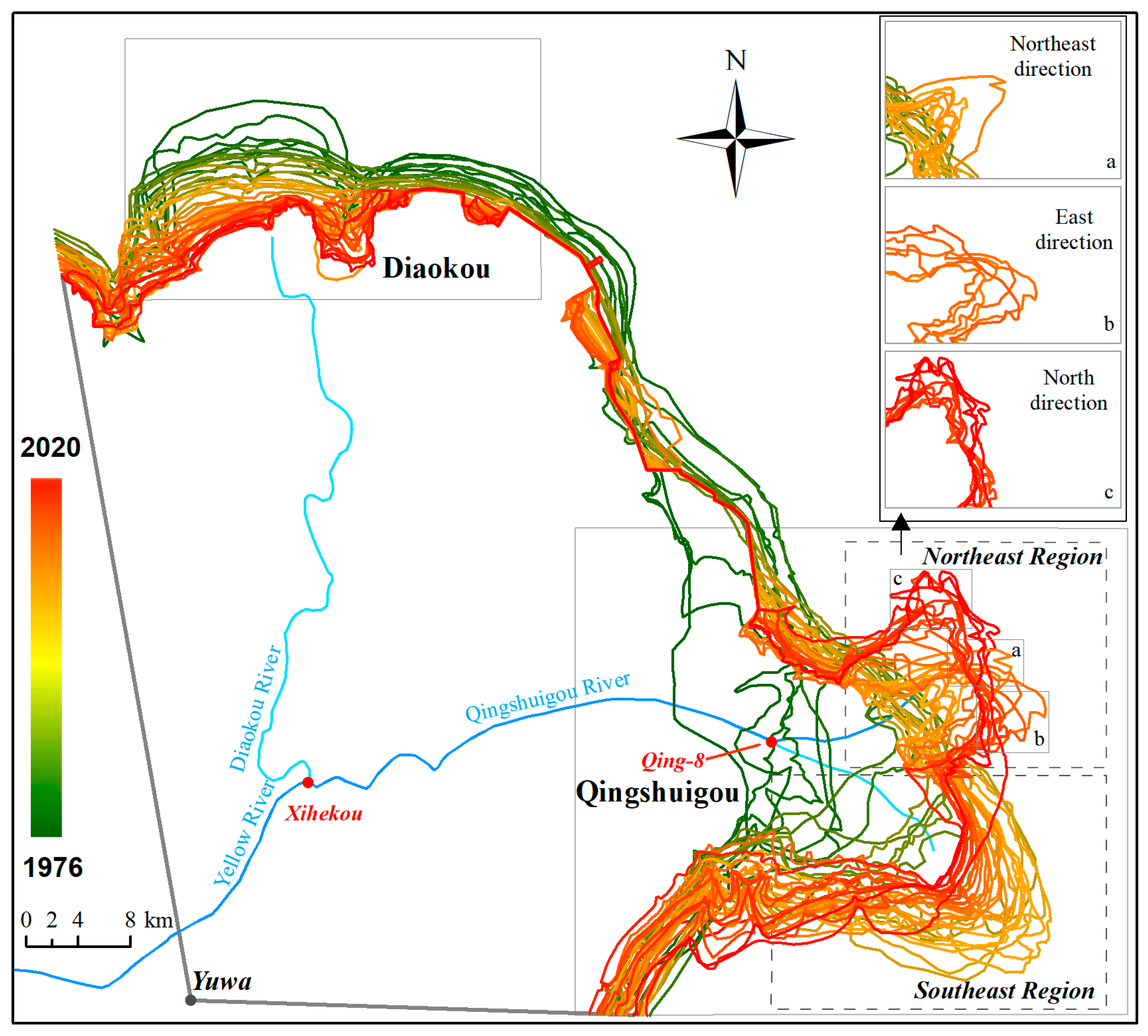
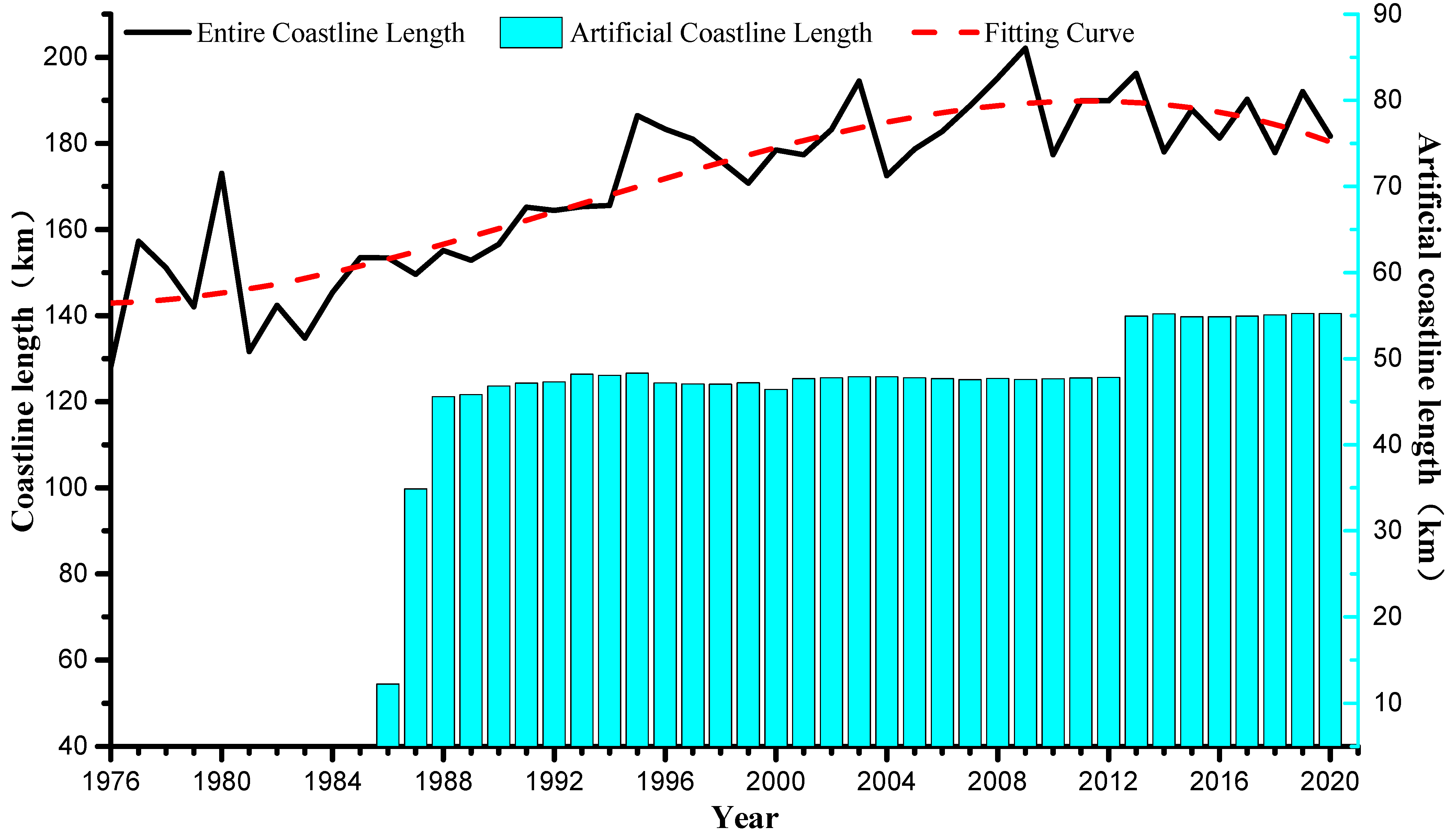
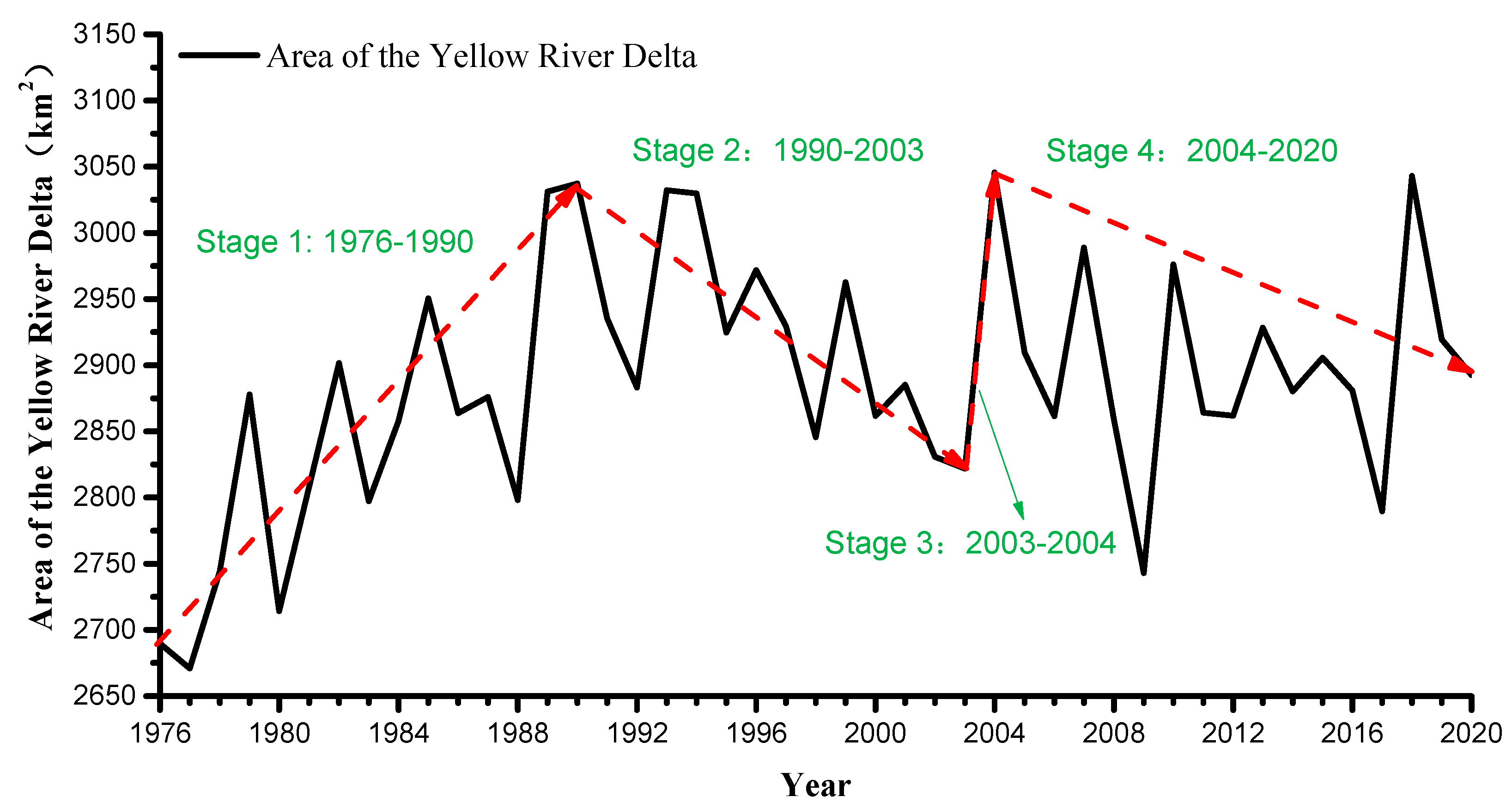
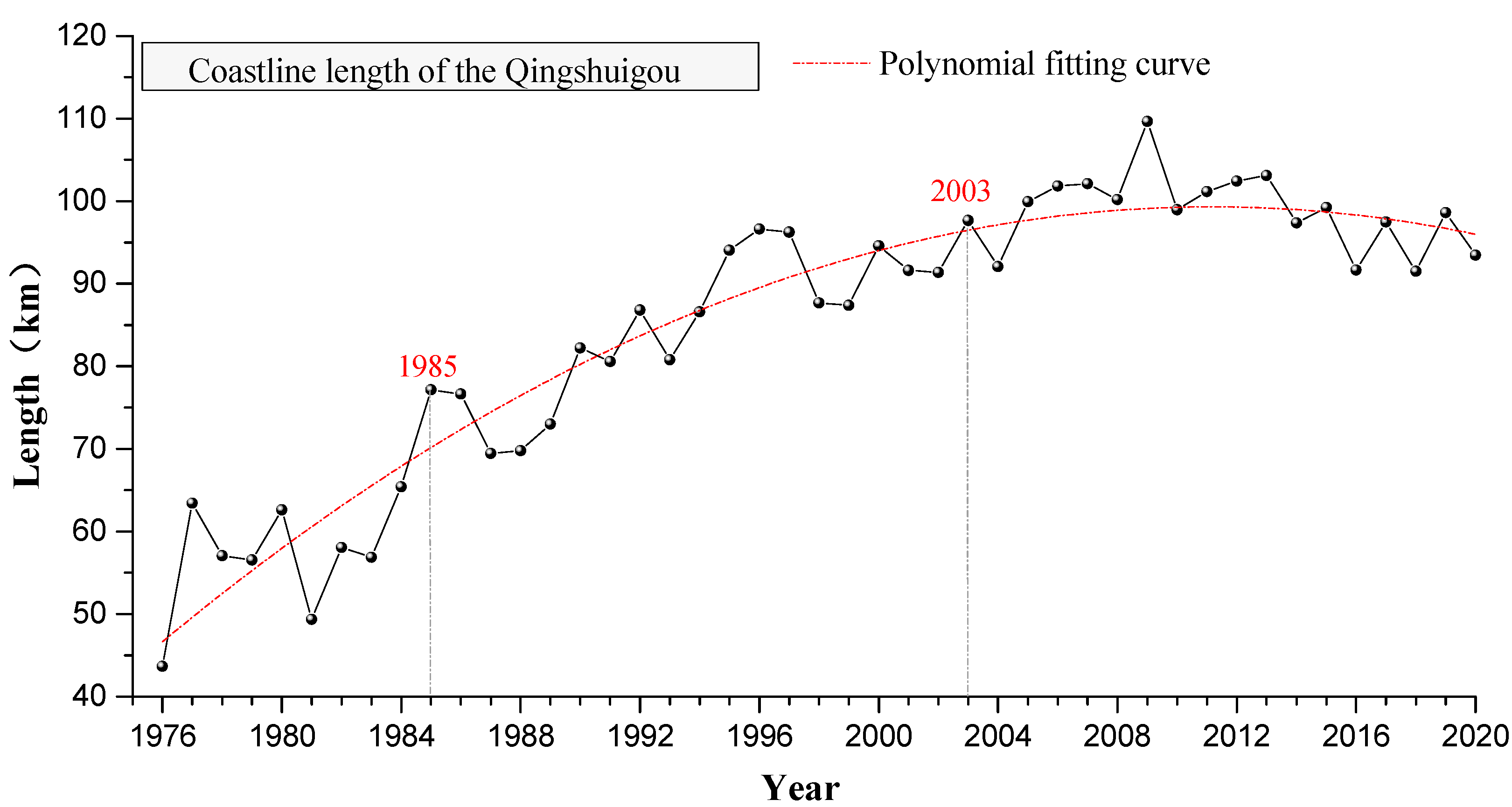
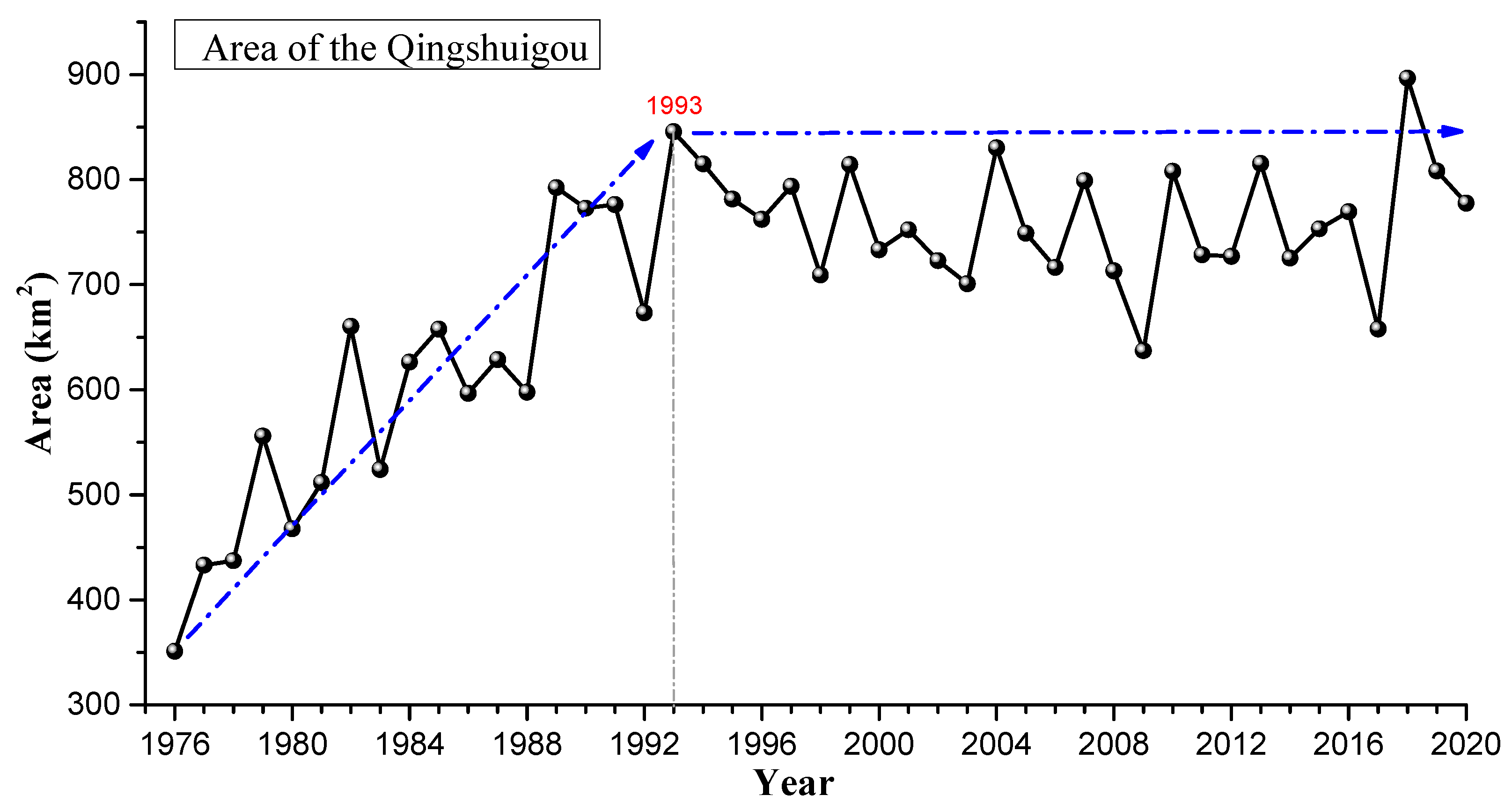
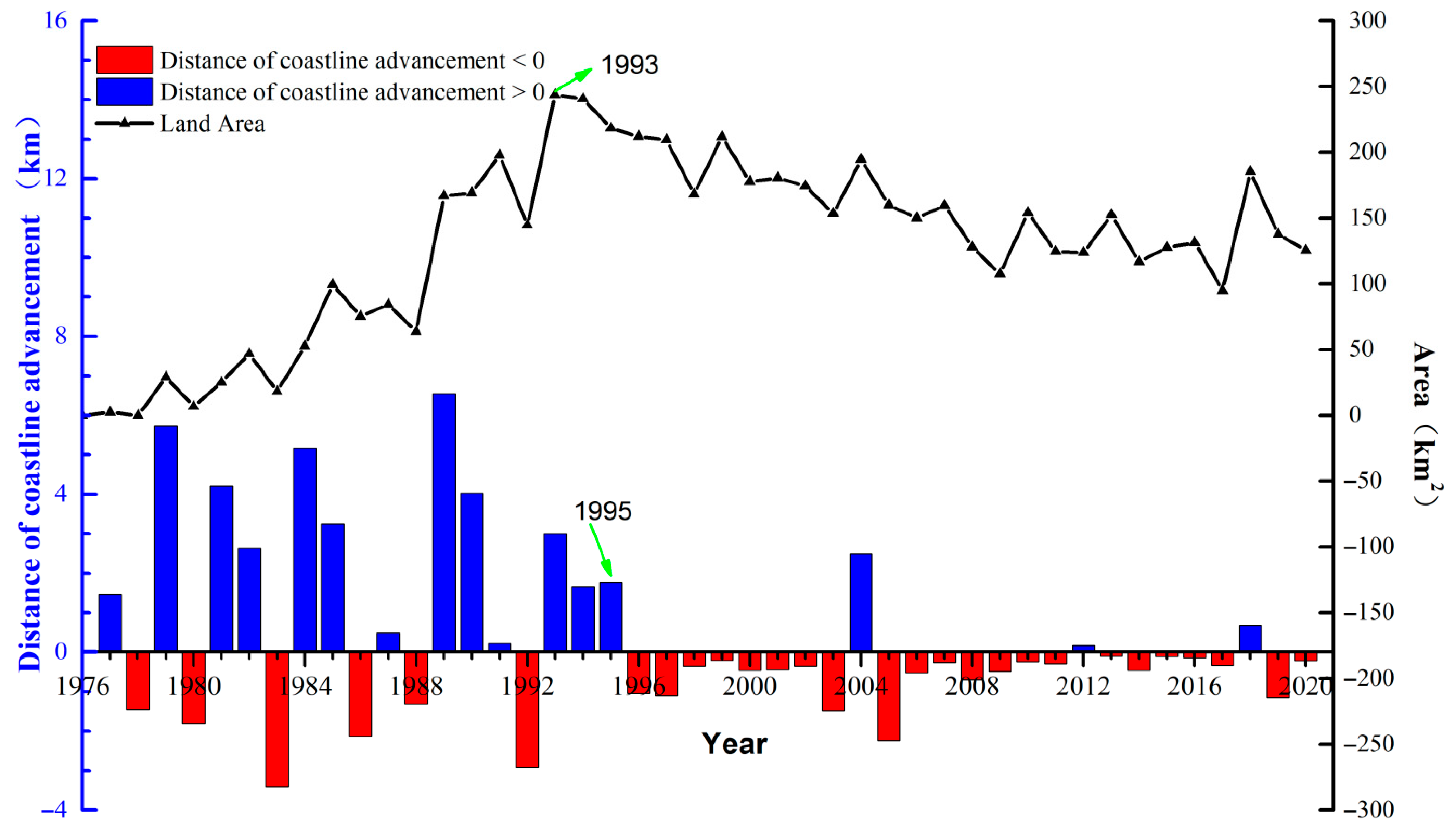

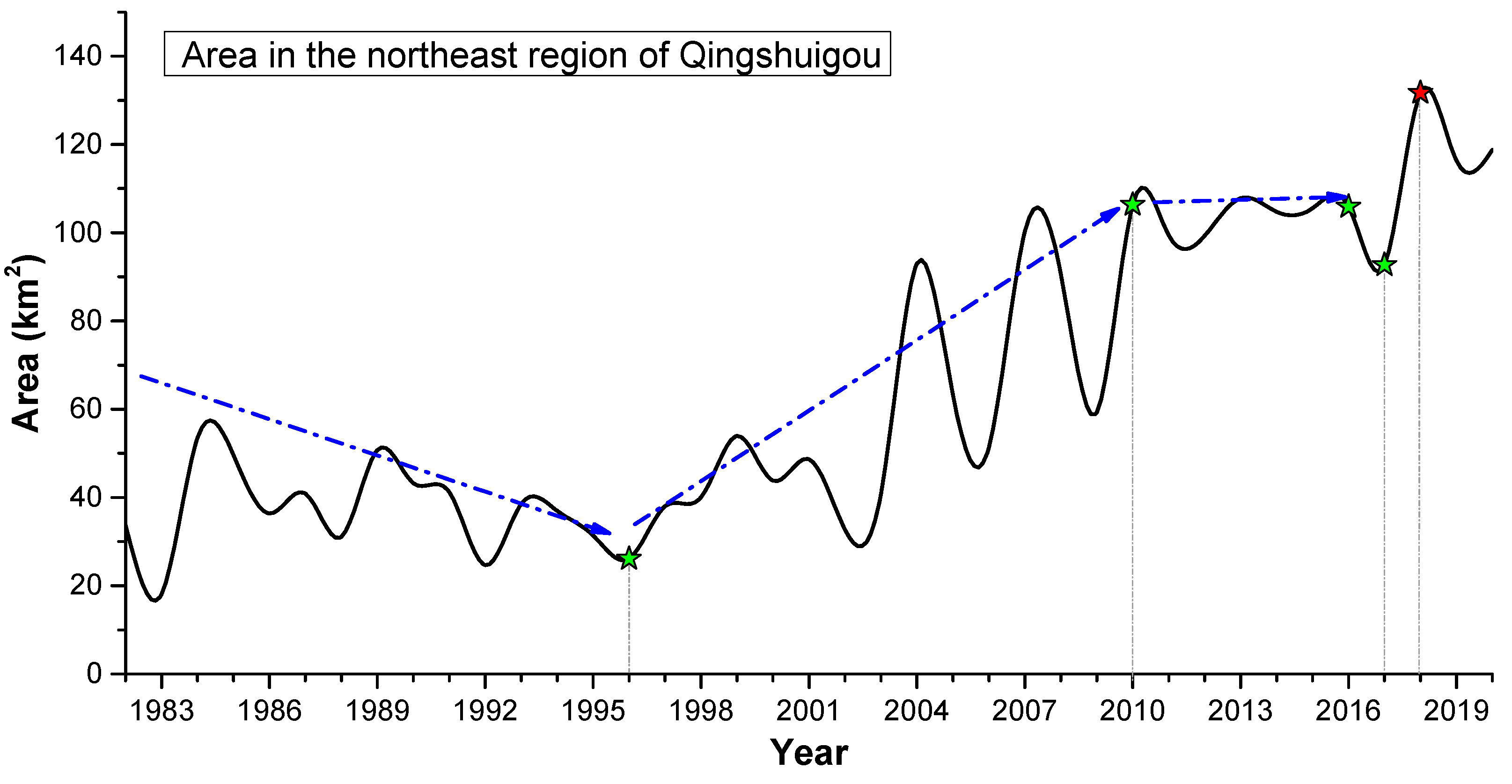


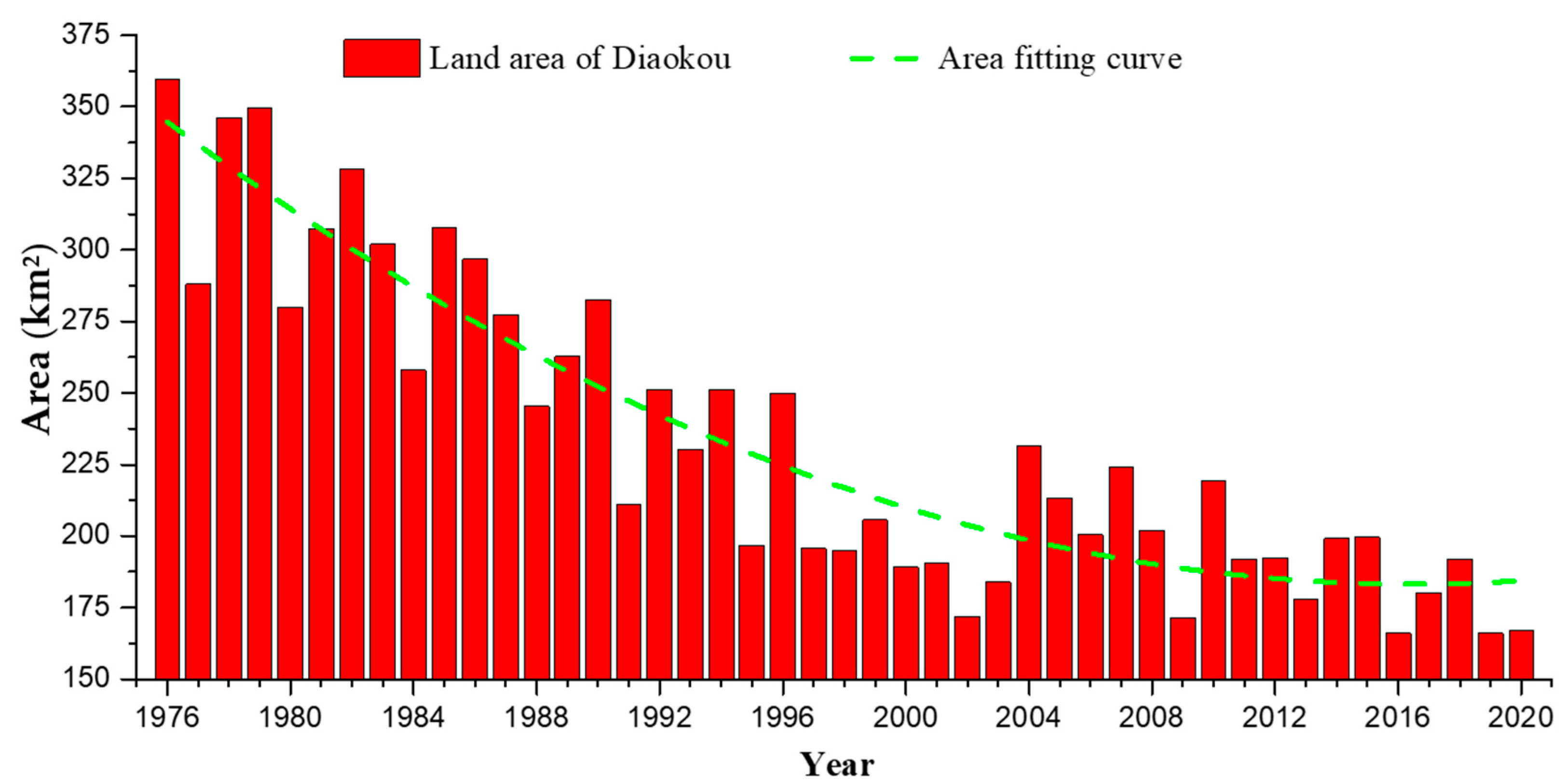
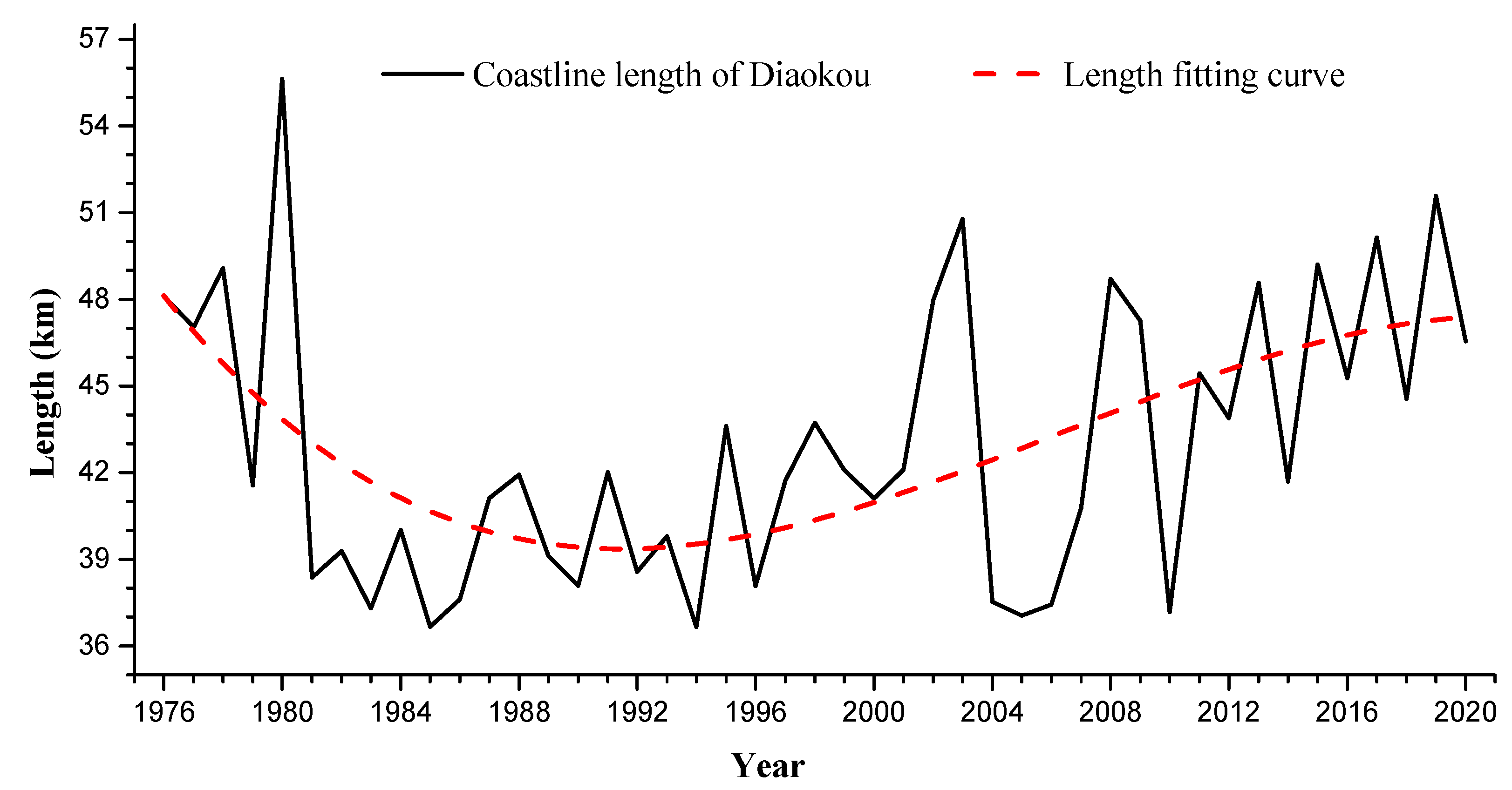
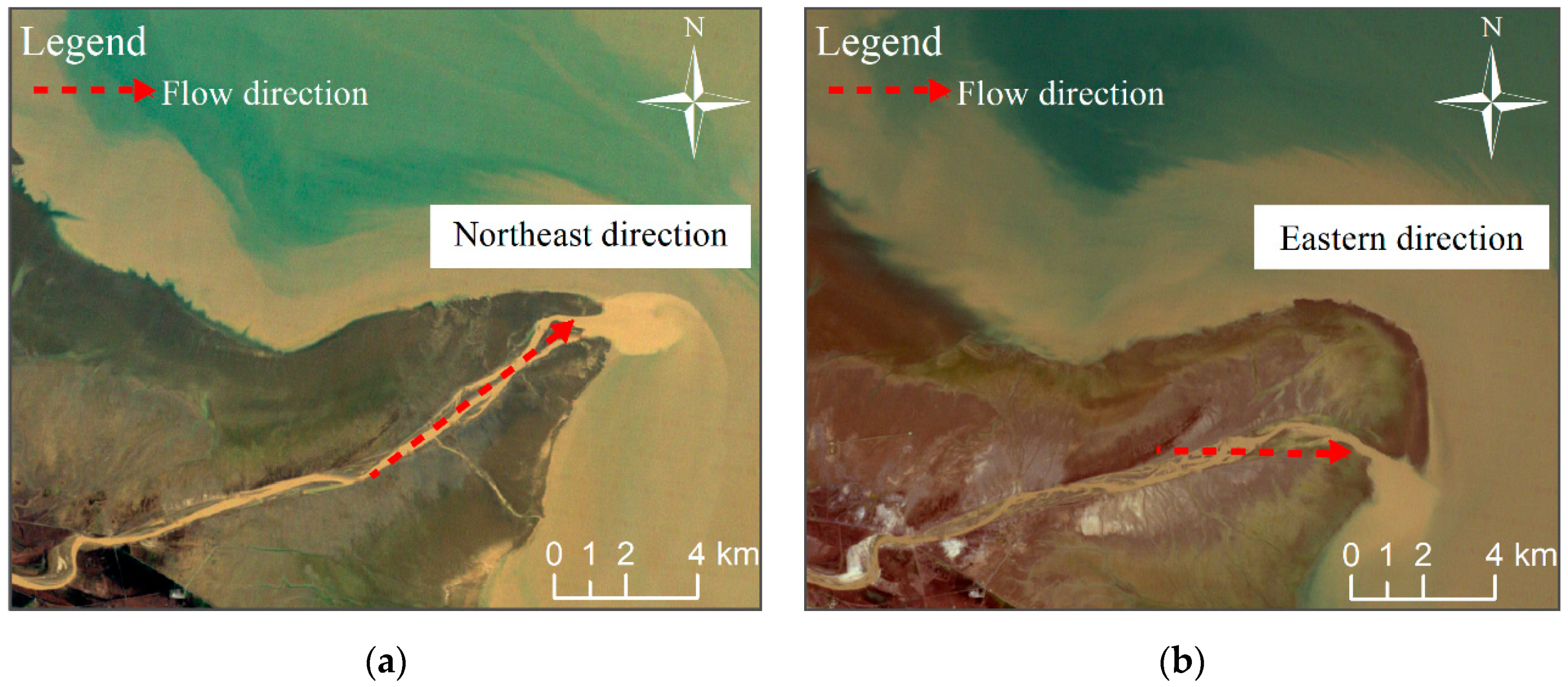
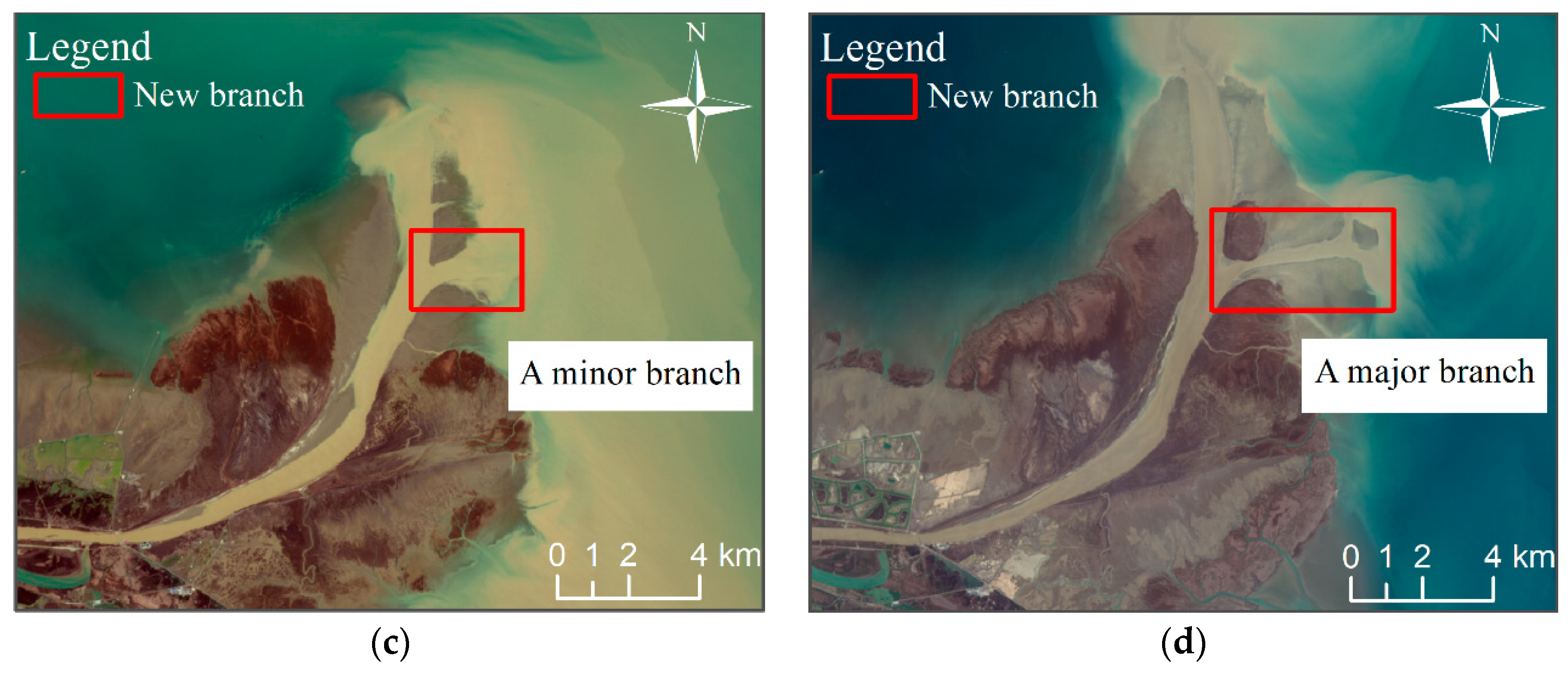
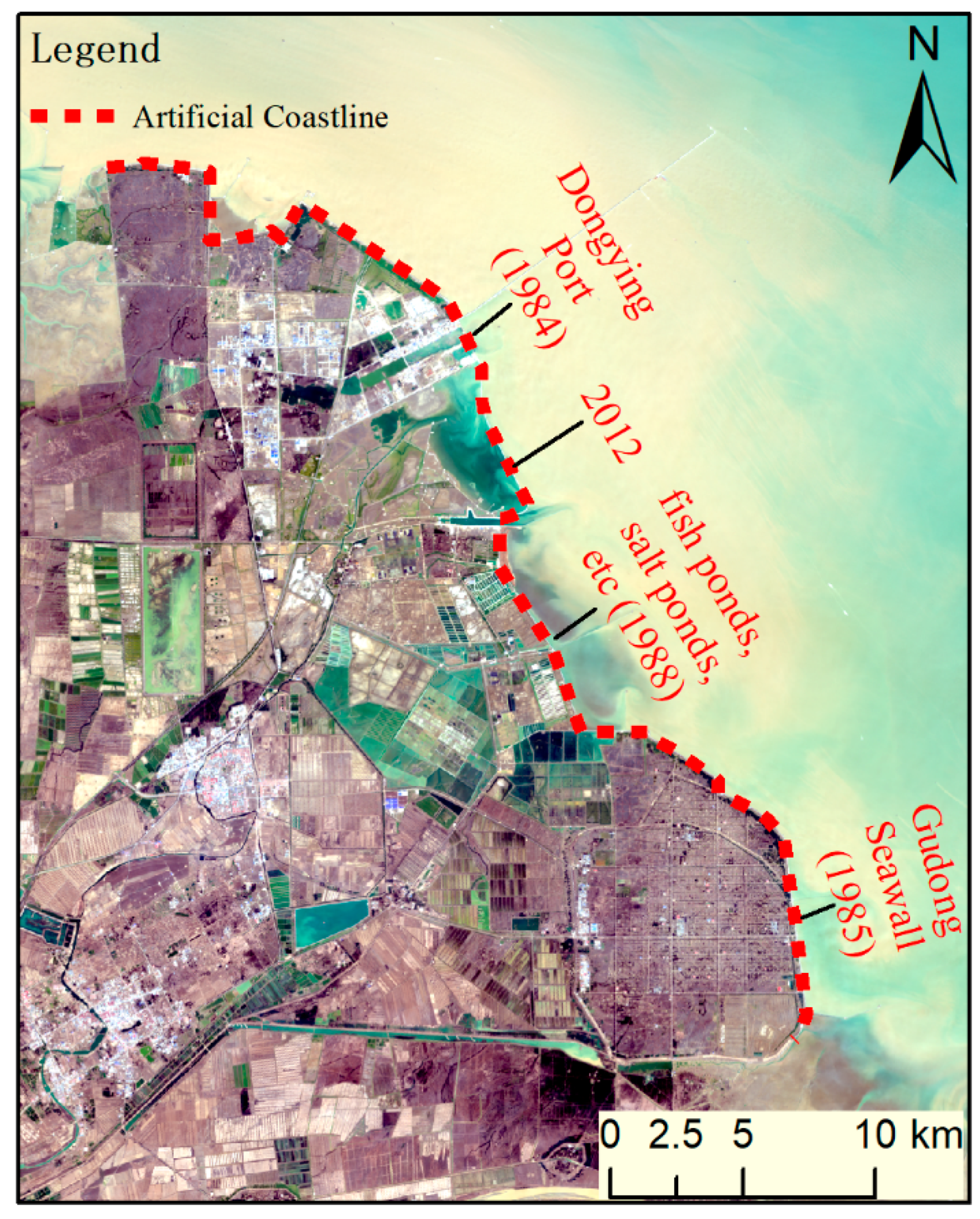
| Id | Date | Sensor | Id | Date | Sensor |
|---|---|---|---|---|---|
| 1 | 1976-06-02 | MSS | 24 | 1999-04-06 | TM |
| 2 | 1977-05-10 | MSS | 25 | 2000-02-28 | ETM+ |
| 3 | 1978-07-07 | MSS | 26 | 2001-03-18 | ETM+ |
| 4 | 1979-11-23 | MSS | 27 | 2002-02-17 | ETM+ |
| 5 | 1980-06-08 | MSS | 28 | 2003-04-25 | ETM+ |
| 6 | 1981-06-12 | MSS | 29 | 2004-02-23 | ETM+ |
| 7 | 1982-02-01 | MSS | 30 | 2005-02-25 | ETM+ |
| 8 | 1983-07-07 | MSS | 31 | 2006-02-12 | ETM+ |
| 9 | 1984-06-07 | MSS | 32 | 2007-02-15 | ETM+ |
| 10 | 1985-11-25 | TM | 33 | 2008-03-05 | ETM+ |
| 11 | 1986-06-05 | TM | 34 | 2009-03-08 | ETM+ |
| 12 | 1987-06-08 | TM | 35 | 2010-06-15 | ETM+ |
| 13 | 1988-06-10 | TM | 36 | 2011-03-30 | ETM+ |
| 14 | 1989-04-10 | TM | 37 | 2012-04-17 | ETM+ |
| 15 | 1990-03-12 | TM | 38 | 2013-04-02 | OLI |
| 16 | 1991-07-05 | TM | 39 | 2014-03-14 | OLI |
| 17 | 1992-04-02 | TM | 40 | 2015-05-04 | OLI |
| 18 | 1993-06-08 | TM | 41 | 2016-03-03 | OLI |
| 19 | 1994-02-03 | TM | 42 | 2017-05-25 | OLI |
| 20 | 1995-03-10 | TM | 43 | 2018-03-09 | OLI |
| 21 | 1996-07-02 | TM | 44 | 2019-02-24 | OLI |
| 22 | 1997-09-07 | TM | 45 | 2020-04-15 | OLI |
| 23 | 1998-05-05 | TM |
Publisher’s Note: MDPI stays neutral with regard to jurisdictional claims in published maps and institutional affiliations. |
© 2021 by the authors. Licensee MDPI, Basel, Switzerland. This article is an open access article distributed under the terms and conditions of the Creative Commons Attribution (CC BY) license (https://creativecommons.org/licenses/by/4.0/).
Share and Cite
Li, C.; Zhu, L.; Dai, Z.; Wu, Z. Study on Spatiotemporal Evolution of the Yellow River Delta Coastline from 1976 to 2020. Remote Sens. 2021, 13, 4789. https://doi.org/10.3390/rs13234789
Li C, Zhu L, Dai Z, Wu Z. Study on Spatiotemporal Evolution of the Yellow River Delta Coastline from 1976 to 2020. Remote Sensing. 2021; 13(23):4789. https://doi.org/10.3390/rs13234789
Chicago/Turabian StyleLi, Chengming, Lining Zhu, Zhaoxin Dai, and Zheng Wu. 2021. "Study on Spatiotemporal Evolution of the Yellow River Delta Coastline from 1976 to 2020" Remote Sensing 13, no. 23: 4789. https://doi.org/10.3390/rs13234789
APA StyleLi, C., Zhu, L., Dai, Z., & Wu, Z. (2021). Study on Spatiotemporal Evolution of the Yellow River Delta Coastline from 1976 to 2020. Remote Sensing, 13(23), 4789. https://doi.org/10.3390/rs13234789







